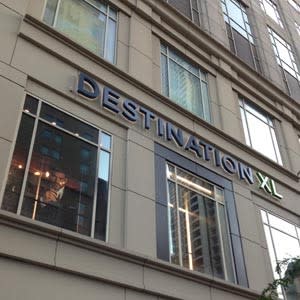After Tough Q1, DXL Group Augmenting Mix With Lower-priced Brands

Destination XL Group was expecting the first quarter to be soft, but it was even worse than expected. As a result, the company has begun adding more lower-price-point brands to serve a cash-strapped consumer.
The Canton, Mass.-based men’s big and tall retailer on Thursday said net income dropped nearly 50 percent in the quarter, falling to $3.8 million, or 6 cents a diluted share, from $7 million, or 11 cents a share, in the same period last year.
More from WWD
Sales declined 7.9 percent to $115.5 million from $125.4 million. Comparable-store sales decreased 11.3 percent — dropping 11.4 percent in stores and 11 percent online. The company attributed the sales decline to a decrease in both traffic and conversion in its 284 stores, with customers buying fewer items and displaying more price sensitivity. One bright spot, however, was that the new stores that opened last fall in Queens, N.Y., Cincinnati and Pasadena, Calif., outperformed the others in the chain, as did the 11 stores that were converted from Casual Male to DXL units.
As a result of the poor quarterly results, DXL updated its guidance for the remainder of the year.
“Based on our current sales trends, we are guiding to the low end of our previous sales guidance, which is $500 million, with a midsingle-digit decrease in comparable sales,” the company said. It is also projecting a 7 percent adjusted earnings before interest, taxes, depreciation and amortization margin for fiscal 2024.
Harvey Kanter, president and chief executive officer, called the results “disappointing,” but said DXL will forge ahead with its plans to invest in “four significant strategic initiatives” to reverse the slide. These include a new brand-building advertising campaign, which is being tested in Boston, Detroit and St. Louis. The campaign will roll out nationally next year.
The second initiative is to open stores where its customers are located. Two have opened so far this year with six additional units slated for later in 2024. “This begins to further address the challenge big and tall men have shared with us in why they do not shop with us with 44 percent of the time because there is no store near them and 35 percent of the time because there is no store conveniently near them,” Kanter said.
At the same time, DXL is transitioning to an improved e-commerce platform that will launch in phases between now and the holiday season, offering a better consumer experience and greater speed.
The final prong of the strategy is an enhanced focus on alliances and collaborations with other retailers such as the one announced in late April with Nordstrom, which has begun offering the DXL assortment in its online marketplace. Kanter said DXL is searching for other partners as well.
During a call with analysts, Kanter said that while sales were lower than expected in the period, the company resisted the “temptation to promote our way to a favorable sales result.” For the customers who did buy, they were attracted to Vineyard Vines, Hugo Boss, Ralph Lauren and Untuckit, the latter of which will be rolling out to 50 stores in the fall from 30 today.
However, he cited research from Adobe that found 55 percent of consumers are now shopping in the lowest quartile of price, up from 32 percent a year ago — a finding that will impact the company’s mix going forward. Three years ago, DXL offered 200 brands, but today, that number is just a little over 100.
“The largest part of the $20 billion plus addressable [big and tall] market is in the mass. DXL is traditionally a moderate or even upper-moderate price point brand. Untuckit or Ralph Lauren or Vineyard Vines are not mass market price points. And so we are losing a customer that is under pressure and has options in the mass market. That being said, we are not trying to be all things to all people because that would be the kiss of death,” the CEO said, adding that DXL will only add 15 to 20 brands at lower price points.
Best of WWD

 Yahoo Finance
Yahoo Finance 